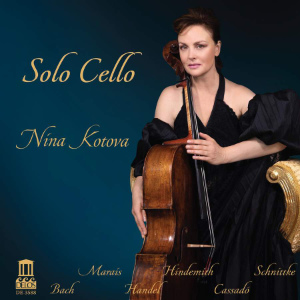
Solo Cello
Marin Marais (1656–1728)
Couplets des Folies d’Espagne from Suite in D minor for Viola da Gamba (arr. Döbereiner and Kotova)
Paul Hindemith (1895-1963)
Sonata for Solo Cello Op25 No.3
Alfred Schnittke (1934-1998)
Klingende Buchstaben
Johann Sebastian Bach (1685–1750)
Suite No.3 in C major for solo cello BWV1009
George Frederick Handel (1685-1759)
Passacaglia from Suite No.7 in D minor HWV 432 (freely arranged by Zinoviy Dynov)
Gaspar Cassadó (1897-1966)
Suite for solo cello
Nina Kotova (cello)
rec. 2021, Museo del Tulle, Panicale, Italy
Reviewed as a download from a press preview
DELOS DE3588 [61]
There is an attractive gutsiness to the tone of Nina Kotova’s cello playing whether in the plangent Slavic tone of her upper register or in the folkie roughness of the lower. It is a beautiful sound but one with the tinge of a life lived to it. Her manner of playing is similarly unabashed. Her unconstrained assault on the Marais which opens this recording announces that she isn’t going to be handling older music with kid gloves. There is a spontaneity to the playing that is excitingly risky that comes from confidence in a rock solid technique which liberates the performer rather than becomes an end in itself.
If anything, her passionate, unbridled playing steps up a gear in Hindemith’s bristling Cello Sonata. I have always downgraded Hindemith as a bit dry, one for the musicologists. Not a chance with Kotova’s feverish advocacy. Apparently, it was written in response to a challenge as to whether the composer could write an entire work in an evening. It certainly reflects the white heat of its genesis in this account.
The short, occasional piece by Alfred Schnittke, Klingende Buchstaben (Sounding Letters) performs that sleight of hand so typical of the enigmatic Russian composer whereby a piece that seems unpromising for most of its duration is transformed by its ending. The title refers to the rendering of letters of the name of its dedicatee, Alexander Ivashkin, into musical notes. Kotova understands the music’s elusive idiom and the end of the piece where the music vanishes upwards into the stratosphere is suitably magical.
Kotova’s handling of the famous Bach C major suite is robust with dance rhythms sturdy like peasants stamping their feet. The style of playing is very much inspired by rather than adopting historically informed practice. The great naturalness with which Kotova ‘breathes’ with the bow, abundantly in evidence elsewhere in the programme, plays a part in her Bach too, albeit in a more restrained fashion. There is no trace of strain to her playing. Is she too gruff for the lovely Sarabande for my liking? I guess so and overall I am left with the impression that this is an account of the suite that works well in the context of this programme but which might not stand the test of comparison with the very best performances of the complete suites. That said it is distinguished Bach playing.
This seems a good moment to mention the sound quality. It is very close but unlike other recent recordings – for some reason all recordings of solo cello these days place the microphones very close – the positioning of the centre of the sound picture seems located near the body of the cello rather than the fretboard. More technically minded readers will, I’m sure, inform that this is technically impossible so what I am describing is an impression. What is noticeable is that, for all the closeness of the sound, we don’t get lots of noise of fingers on the fretboard as in other recordings. What we do get, to my ears, is the rich, resonant belly of the instrument. Which is probably a long winded way of saying I found the sound a real pleasure. With a lot of cello writing concentrated on the upper strings, it is nice to hear the depths of the instrument’s sound so ripely presented.
The next track after the Bach had me reaching for the liner notes – isn’t this meant to be Handel? The devil is in the detail- Handel, yes, but ‘freely arranged by Zinoviy Dynov’. Put the emphasis on the word ‘freely’ and you’ll get a better idea of why this track surprised me. This piece is closer to Shostakovich than any of the Handel keyboard suites I know. It was a surprise but certainly not a problem. This style is very much Kotova’s forte with agonised melodic lines and crunching, grim chords.
The piece also bridges the stylistic gap to the concluding work – the sonata for solo cello by the twentieth century Spanish composer and cellist, Gaspar Cassado. Another gritty work but one full of dark Iberian passions and, in the concluding movement, sexy flamenco dance rhythms. Kotova is in her element in this work and it is immensely persuasive advocacy of a piece probably better known to cello fanciers than general listeners. In Kotova’s hands, and the sound of her playing is absolutely resplendent, it definitely deserves to be better known and crowns the recital.
I have a suspicion that this recording reflects a regular concert programme of Kotova’s. The way the pieces work together has the feel of practical experience and, unlike many recital discs which hang together on account of a clever idea or theme, this one makes good musical sense and sends the listener home (so to speak) satisfied. This is the sound of a seasoned musical talent in her absolute prime playing with confidence, sensitivity and flair in carefully and imaginatively chosen repertoire that suits her musical personality perfectly. What more could a listener ask for?
David McDade
Help us financially by purchasing from





















